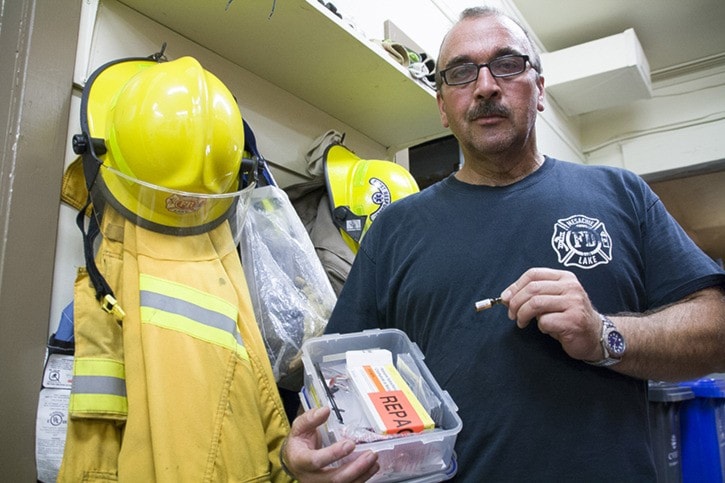A powerful intoxicant like fentanyl is probably the last thing one associates with Mesachie Lake, the tiny community best known for its ball park — the “Sky Dome” — and Camp Imadene. However, the community’s fire chief and deputy chief have become the first around the Lake to receive special training in administering Naloxone, a drug used to reverse the effects of opioid overdoses and most commonly associated with the growing number of fentanyl-related deaths in B.C.
Gary Eve, chief of the Mesachie Lake Fire Department, said when he and his deputy chief learned a Naloxone (better known by its brand name, Narcan) training session was being offered for free in Parksville, they jumped on the opportunity.
“It was available to us. As volunteers, especially within a small department, when things come up you take them,” he said.
Earlier this month, the British Columbia Coroners Service released its latest statistics about incidents in which fentanyl was indicated in deaths resulting from illicit drug use. Between January and June of this year, there have been 48 fentanyl-detected deaths on Vancouver Island alone. That’s more than double the fentanyl-detected deaths (22) on Vancouver Island throughout all of 2015.
Eve said there are a number of steps he and other Narcan-trained firefighters must complete before they can administer the drug.
“There has to be a really good suspicion that this was a drug-related, an opioid-related case, so we’d either have to find the needle and the spoon and the candle or we have to find the oxicodone bottle, pinpoint pupils,” he said. The victim must also not be breathing or require assistance breathing. Then the responding firefighter needs to phone Emergency Physician Online Support.
“We relay to them what we found and then they give us the permission to do two shots.”
Eve pointed out that drug addicts are not the only people who could potentially require Narcan, citing unintentional overdoses of prescribed pain medication.
Also because fentanyl can be absorbed through the skin, first responders arriving on a scene where fentanyl is present are at an elevated risk of coming into contact with the drug and potentially requiring Narcan treatment themselves.
The drug is administered in one milligram doses through a retractable syringe to the arm. Cost of the drug is minimal (about $2) with the syringes comparably priced.
Eve said his ability to administer the drug has nothing to do with taking jobs away from paramedics, and he emphasizes the good working relationship between his team and local paramedics.
“This is about treating people. Our department goes way out in the middle of nowhere on the circle route and you don’t have to listen to the pager for very long to hear a lot of the first responder calls are ambulance delayed 30 minutes,” he said.
His philosophy: Having an additional tool in the department’s tool kit can’t be a bad thing.
“Do we expect to see drug overdoses in Mesachie Lake? Well, no, but we don’t expect to see heart attacks but we all have CPR. We pack an AED [automated external defibrillator],” he said.
Deputy fire chief Owen Robertson echoed these sentiments, noting the policing priorities of the RCMP’s drug lab team change every few years.
“It used to be they looked quite seriously at grow-ops and they ignore them because they’re not even a factor. It’s these newer drugs we’re seeing in the news, these fentanyl-type things that are becoming more of an issue,” he said.
“It used to be that we just saw it in the major urban centres, but now it covers the province. It’s everywhere, it doesn’t matter if it’s a big town or a small town.”
Robertson and Eve are currently the only members of the Mesachie Lake Volunteer Fire Department trained to administer Narcan, however, they are also certified to train other first responders.
Their goal is to eventually have all their firefighters licensed and prepared to use Narcan if necessary.
